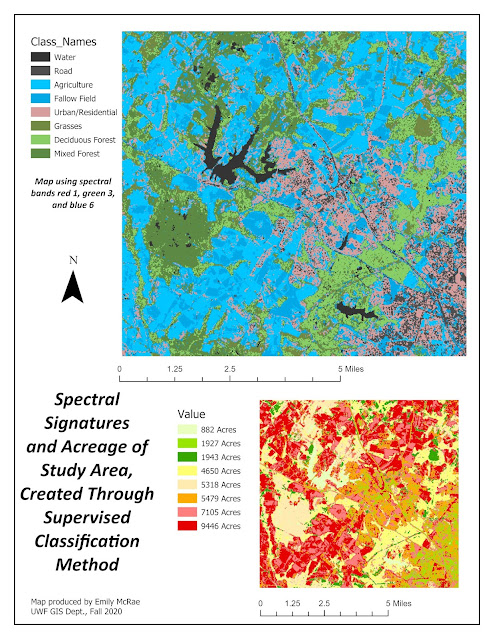GIS 5935 Module 5
This weeks module focused on surface interpolation using the Spline, Thiessen, and Inverse Distance Weighted (IDW) methods.
In the example below, water quality sample points taken across Tampa Bay were used as input data and run through the 3 surface interpolation methods to get an understand of water quality across the entire Tampa Bay study area. The methods are compared based on their ability to achieve a good impression of what water quality may actually look like across the surface.
I will detail how each method works, their strengths and limitations as it applies to this example, and the result of this method when applied to Tampa Bay water quality assessment.
I will note that none of these methods take into account other highly influential factors of the water landscape including flow direction, elevation, watershed, aquifer boundaries, etc.
Spline
Conceptually, how it works: The spline method interpolated the value of the surface where data points are not recorded, by passing a layer through each point to create a false surface. I imagine this as something like a flowing bedsheet, that gets draped across points and is allowed to drape inward with empty space between points.
Strengths and limitations: This method assumes a gradual flow from one point to the next, which may not always best reflect the true environment. In fact, in this example, a correction was actually made to the original data set through the addition of a point to get better quality results out of this tool. This method is appealing in that it actually creates a surface that seemingly flows, as does water, however it very tightly follows borders of points and this results in a steep drop or rise in values.
 |
| Resulting regularized spline surface interpolation with one additional averaged point showing water quality in the Tampa Bay area. |
Thiessen
Conceptually, how it works: This method draws polygons across a surface. The polygons are drawn around areas without values to reflect the area that is closest to a known single point. In this way, all polygons are assigned the uniform value of the point that is nearest to them. As stated in the text, this method is the simplest of interpolation methods and can even be done by hand. That means that the concept is simple to understand and to implement. The data values are also preserved because no values for unsampled areas are actually recalculated, they are only assigned those values which were known to be true for that locations nearest neighbor (Bolstad, 2016, Chpt 12).
This method does not, however, produce the most accurate
representation of phenomena. It creates polygons with solid boundaries between
them, and there is no blending or gradient between values across a surface.
This could be seen as a good thing, in that its assumptions are very clearly
identifiable, but nonetheless it creates the least accurate representation of
the actual surface of any of the methods.
Strengths and limitations: This method is the simplest of interpolation methods and can even be done by hand. That means that the concept is simple to understand and to implement. The data values are also preserved because no values for unsampled areas are actually recalculated, they are only assigned those values which were known to be true for that locations nearest neighbor (Bolstad, 2016, Chpt 12). This method does not, however, produce the most accurate representation of phenomena. It creates polygons with solid boundaries between them, and there is no blending or gradient between values across a surface. This could be seen as a good thing, in that its assumptions are very clearly identifiable, but nonetheless it creates the least accurate representation of the actual surface of any of the methods. As it applies to water quality, it is highly unlikely that this output would at all accurately represent the quality of water across a surface. The boundaries are highly unnatural and abrupt, and there is no representation of flow.
 |
| Thiessen polygon surface interpolation of Tampa Bay water quality. |
IDW
Conceptually, how it works: This method draws circles around undefined areas using some defined radius; either by distance or by number of points that must be contained in a circle. This is logically similar to buffer zones in a way, only that the 'buffers' are defined by a set of points and there is an outward gradient applied. As a location gets farther from the center of a circle, the likeness it is assumed to share with that circle decreases.
Strengths and limitations: This method seems very good for identifying zones in which phenomena may take place, but its assumption about the distance from some center point is too defined to mimic a natural water environment. On the other hand, this method allows a bit more specificity on the end of the analyst than do the other methods.
 |
| IDW surface interpolation of Tampa Bay water quality. |
Sources:
Bolstad, P. (2016). GIS Fundamentals: A First Text on Geographic Information Systems, Fifth Edition (5th edition). XanEdu Publishing Inc.



Comments
Post a Comment